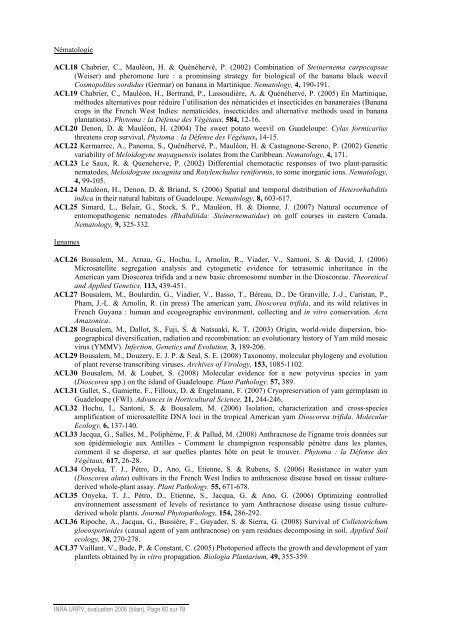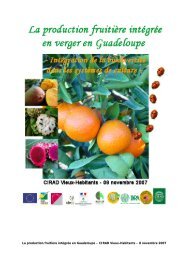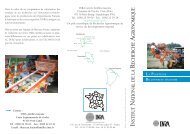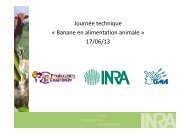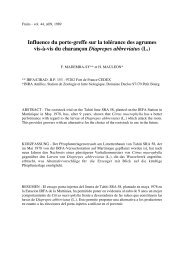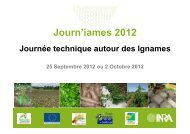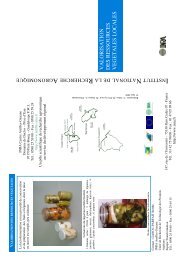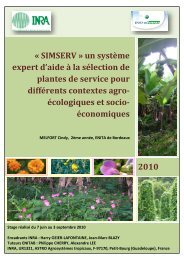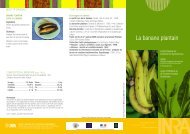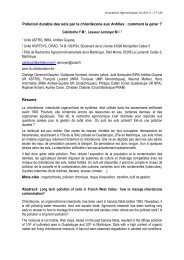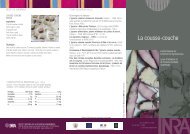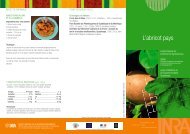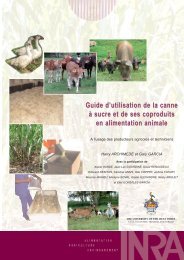Bilan-Scientifique UR979 - Inra
Bilan-Scientifique UR979 - Inra
Bilan-Scientifique UR979 - Inra
You also want an ePaper? Increase the reach of your titles
YUMPU automatically turns print PDFs into web optimized ePapers that Google loves.
NématologieACL18 Chabrier, C., Mauléon, H. & Quénéhervé, P. (2002) Combination of Steinernema carpocapsae(Weiser) and pheromone lure : a prominsing strategy for biological of the banana black weevilCosmopolites sordidus (Germar) on banana in Martinique. Nematology, 4, 190-191.ACL19 Chabrier, C., Mauléon, H., Bertrand, P., Lassoudière, A. & Quénéhervé, P. (2005) En Martinique,méthodes alternatives pour réduire l’utilisation des nématicides et insecticides en bananeraies (Bananacrops in the French West Indies: nematicides, insecticides and alternative methods used in bananaplantations). Phytoma : la Défense des Végétaux, 584, 12-16.ACL20 Denon, D. & Mauléon, H. (2004) The sweet potato weevil on Guadeloupe: Cylas formicariusthreatens crop survival. Phytoma : la Défense des Végétaux, 14-15.ACL22 Kermarrec, A., Panoma, S., Quénéhervé, P., Mauléon, H. & Castagnone-Sereno, P. (2002) Geneticvariability of Meloidogyne mayaguensis isolates from the Caribbean. Nematology, 4, 171.ACL23 Le Saux, R. & Queneherve, P. (2002) Differential chemotactic responses of two plant-parasiticnematodes, Meloidogyne incognita and Rotylenchulus reniformis, to some inorganic ions. Nematology,4, 99-105.ACL24 Mauléon, H., Denon, D. & Briand, S. (2006) Spatial and temporal distribution of Heterorhabditisindica in their natural habitats of Guadeloupe. Nematology, 8, 603-617.ACL25 Simard, L., Belair, G., Stock, S. P., Mauléon, H. & Dionne, J. (2007) Natural occurrence ofentomopathogenic nematodes (Rhabditida: Steinernematidae) on golf courses in eastern Canada.Nematology, 9, 325-332.IgnamesACL26 Bousalem, M., Arnau, G., Hochu, I., Arnolin, R., Viader, V., Santoni, S. & David, J. (2006)Microsatellite segregation analysis and cytogenetic evidence for tetrasomic inheritance in theAmerican yam Dioscorea trifida and a new basic chromosome number in the Dioscoreae. Theoreticaland Applied Genetics, 113, 439-451.ACL27 Bousalem, M., Boulardin, G., Viadier, V., Basso, T., Béreau, D., De Granville, J.-J., Caristan, P.,Pham, J.-L. & Arnolin, R. (in press) The american yam, Dioscorea trifida, and its wild relatives inFrench Guyana : human and ecogeographic environment, collecting and in vitro conservation. ActaAmazonica.ACL28 Bousalem, M., Dallot, S., Fuji, S. & Natsuaki, K. T. (2003) Origin, world-wide dispersion, biogeographicaldiversification, radiation and recombination: an evolutionary history of Yam mild mosaicvirus (YMMV). Infection, Genetics and Evolution, 3, 189-206.ACL29 Bousalem, M., Douzery, E. J. P. & Seal, S. E. (2008) Taxonomy, molecular phylogeny and evolutionof plant reverse transcribing viruses. Archives of Virology, 153, 1085-1102.ACL30 Bousalem, M. & Loubet, S. (2008) Molecular evidence for a new potyvirus species in yam(Dioscorea spp.) on the island of Guadeloupe. Plant Pathology, 57, 389.ACL31 Gallet, S., Gamiette, F., Filloux, D. & Engelmann, F. (2007) Cryopreservation of yam germplasm inGuadeloupe (FWI). Advances in Horticultural Science, 21, 244-246.ACL32 Hochu, I., Santoni, S. & Bousalem, M. (2006) Isolation, characterization and cross-speciesamplification of microsatellite DNA loci in the tropical American yam Dioscorea trifida. MolecularEcology, 6, 137-140.ACL33 Jacqua, G., Salles, M., Poliphème, F. & Pallud, M. (2008) Anthracnose de l'igname trois données surson épidémiologie aux Antilles - Comment le champignon responsable pénètre dans les plantes,comment il se disperse, et sur quelles plantes hôte on peut le trouver. Phytoma : la Défense desVégétaux, 617, 26-28.ACL34 Onyeka, T. J., Pétro, D., Ano, G., Etienne, S. & Rubens, S. (2006) Resistance in water yam(Dioscorea alata) cultivars in the French West Indies to anthracnose disease based on tissue culturederivedwhole-plant assay. Plant Pathology, 55, 671-678.ACL35 Onyeka, T. J., Pétro, D., Etienne, S., Jacqua, G. & Ano, G. (2006) Optimizing controlledenvironnement assessment of levels of resistance to yam Anthracnose disease using tissue culturederivedwhole plants. Journal Phytopathology, 154, 286-292.ACL36 Ripoche, A., Jacqua, G., Bussière, F., Guyader, S. & Sierra, G. (2008) Survival of Colletotrichumgloeosporioides (causal agent of yam anthracnose) on yam residues decomposing in soil. Applied Soilecology, 38, 270-278.ACL37 Vaillant, V., Bade, P. & Constant, C. (2005) Photoperiod affects the growth and development of yamplantlets obtained by in vitro propagation. Biologia Plantarium, 49, 355-359.INRA URPV, évaluation 2008 (bilan), Page 60 sur 79


